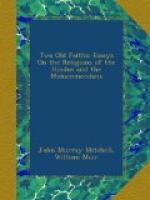[Sidenote: Deterioration begins early.] Indra, if provided with Soma, is always indulgent to his votaries; he supports them per fas et nefas. Varuna, on the other hand, is grave, just, and to wicked men severe.[12] The supersession of Varuna by Indra, then, is easily understood. We see the principle on which it rests stated in the Old Testament. “Ye cannot serve the Lord,” said Joshua to the elders of Israel; “for he is a holy God.” Even so Jeremiah points sorrowfully to the fact that the pagan nations clung to their false gods, while Israel was faithless to the true. As St. Paul expresses it, “they did not like to retain God in their knowledge.” Unless this principle is fully taken into account we cannot understand the historical development of Hinduism.
[Sidenote: Varuna the only divinity possessed of pure and elevated attributes.] The Veda frequently ascribes to the gods, to use the language of Max Mueller, “sentiments and passions unworthy of deity.” In truth, except in the case of Varuna, there is not one divinity that is possessed of pure and elevated attributes.
II.
PHILOSOPHY, AND RITUALISM.
[Sidenote: Speculation begins. Rise of asceticism. Upanishads. They are pantheistic.] During the Vedic period—certainly toward its conclusion—a tendency to speculation had begun to appear. Probably it had all along existed in the Hindu mind, but had remained latent during the stirring period when the people were engaged in incessant wars. Climate, also, must have affected the temperament of the race; and, as the Hindus steadily pressed down the valley of the Ganges into warmer regions, their love of repose and contemplative quietism would continually deepen. And when the Brahmans became a fully developed hierarchy, lavishly endowed, with no employment except the performance of religious ceremonies, their minds could avoid stagnation only by having recourse to speculative thought. Again, asceticism has a deep root in human nature; earnest souls, conscious of their own weakness, will fly from the temptations of the world. Various causes thus led numbers of men to seek a life of seclusion; they dwelt chiefly in forests, and there they revolved the everlasting problems of existence, creation, the soul, and God. The lively Greeks, for whom, with all their high intellectual endowments, a happy sensuous existence was nearly all in all, were amazed at the numbers in northern India who appeared weary of the world and indifferent to life itself. By and for these recluses were gradually composed the Aranyakas, or forest treatises; and out of these grew a series of more regular works, called Upanishads.[13] At least two hundred and fifty of these are known to exist. They have been called “guesses at truth;” they are more so than formal solutions of great questions. Many of them are unintelligible rhapsodies; others rise almost to sublimity. They frequently contradict




